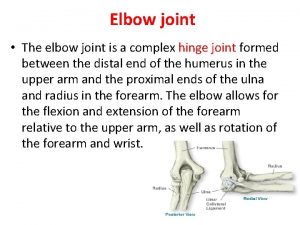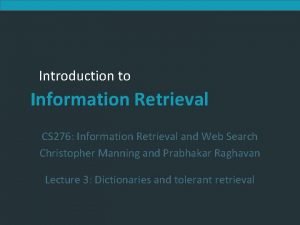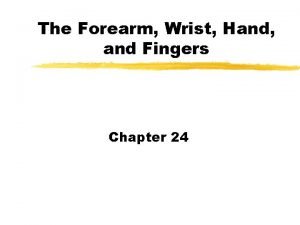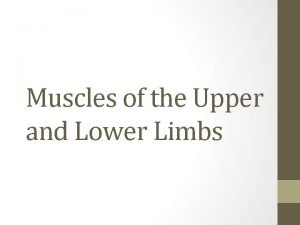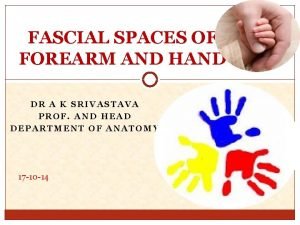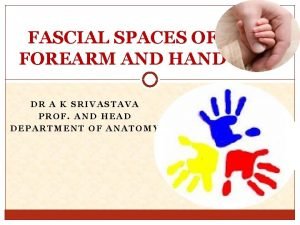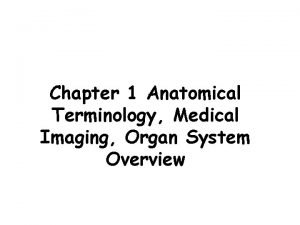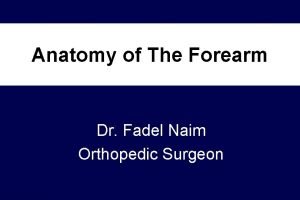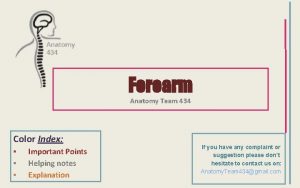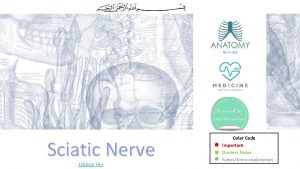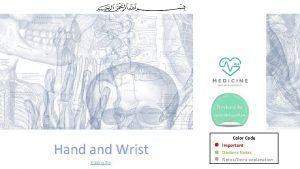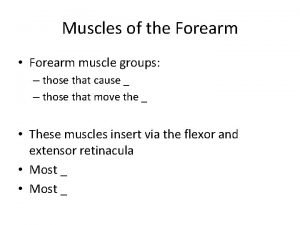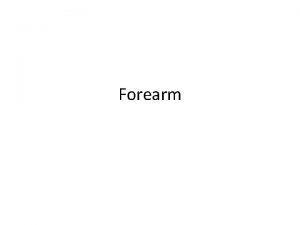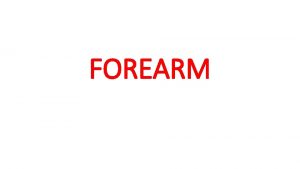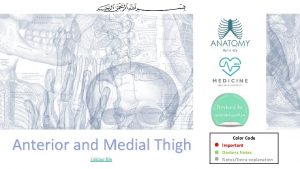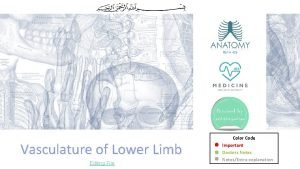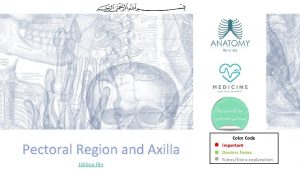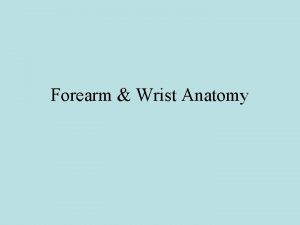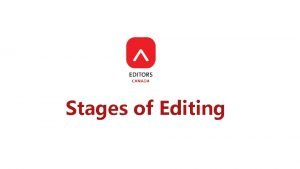Anatomy of Forearm Editing File Color Code Important

























- Slides: 25

Anatomy of Forearm Editing File Color Code Important Doctors Notes/Extra explanation

Objectives • At the end of this lecture, the student should able to: 1. List the names of the Flexors Group of Forearm (superficial & deep muscles). 2. Identify the common flexor origin of flexor muscles and their innervation & movements. 3. Identify supination & pronation and list the muscles produced these 2 movements. 4. List the names of the Extensor Group of Forearm (superficial & deep muscles). 5. Identify the common extensor origin of extensor muscles and their innervation & movements.

Recall what we took in foundation: The following pairs always come together (they counter each other so if one is present so is the other) Flexor & Extensor (flexor carpi ulnaris & extensor carpi ulnaris) Longus & Brevis (extensor carpi radialis longus & extensor carpi radialis brevis) Superficialis & Profundus (flexor digitorum superficialis & flexor digitorum profundus) Major & Minor (pectoralis major & pectoralis minor) The fingers: Digitorum = has 4 tendons each attached to a finger Pollicis = the thumb Indices = index finger ﺍﻟﺴﺒﺎﺑﻪ Digiti minimi = pinkie

FOREARM • - The forearm extends from elbow to wrist • - It posses two bones radius laterally & Ulna medially. • The two bones are connected together by the interosseous membrane. This membrane: 1 - allows movement of Pronation and Supination while the two bones are connected together. 2 - it gives origin for the deep muscles. - The radius and ulna are connected by 3 structures: the interosseous membrane, superior radioulnar joint and inferior radioulnar joint - An interosseous membrane is a broad and thin plane of fibrous tissue that separates many of the bones of the body.

Fascial Compartments of the Forearm o The forearm is enclosed in a sheath of deep fascia, which is attached to the posterior border of the ulna. o This fascial sheath, together with the interosseous membrane & fibrous intermuscular septa, divides the forearm into several compartments, each having its own muscles, nerves, and blood supply.

EXTRA

FLEXOR GROUP These muscles: 8 • Act on the elbow & wrist joints and those of the fingers • Form fleshy masses in the proximal part and become tendinous in the distal part of the forearm.

FLEXOR GROUP Superficial flexors: *All Arise(originate) from the common flexor origin (front of medial epicondyle) Common fascia Pronator teres Flexor carpi radialis *All are supplied by the Median nerve Except One > (FCU). *(FCU): supplied by the Ulnar nerve. *All cross the wrist joint Except one > Pronator teres (it is short) Palmaris longus Flexor carpi ulnaris Median nerve

1) Pronator teres Insertion: middle of lateral surface of radius. Action: pronation & flexion of forearm. 2) Flexor Carpi Radialis Insertion: Base of 2 nd metacarpal bone. Action: Flexion & abduction of the Hand. Note: Radialis always inserts at either 2/3 metacarpal since they are lateral. Ulnaris always inserts at 5 th metacarpal because it is medial. 3) Palmaris Longus Insertion: flexor retinaculum & palmar aponeurosis. (thickening of deep fascia at the wrist gives flexor retinaculum. And thickening of deep fascia at palm gives the palmar aponeurosis) Action: Flexes hand & tightens palmar aponeurosis 4) Flexor Carpi Ulnaris Insertion: *Pisiform *Hook of hamate *5 th metacarpal bone Action: Flexion and adduction of the hand. All have the Same origin in front of medial epicondyle 2 nd

FLEXOR GROUP Intermediate flexors: Flexor Digitorum Superficialis Origin: • ( Common flexor origin ''medial epicondyle" ) • ( Coronoid process of ulna ) • ( Anterior surface of radius ) Insertion: Base of middle phalanges of medial 4 fingers. Action: Flexes middle and proximal phalanges of medial 4 fingers, and the hand. https: //youtu. be/i. DXUw. Ertt. JA

FLEXOR GROUP Note: The anterior interosseous nerve is a branch of the median nerve Where as the posterior interosseous nerve is the deep branch of the radial nerve Deep Flexors: Flexor Digitorum profundus: Flexor pollicis longus Pronator Quadratus. • Origin: Above / in front of Ulna • Origin: Above/in front of Radius • Origin: Above the 2 bones • Insertion: bases of distal phalanges • Insertion: Base of distal phalanx of thumb of medial 4 digits • Action: flexes interphalangeal, • Action: Flexes distal phalanges of metacarpophalangeal & carpometacarpal medial 4 digits. joints of thumb. (all thumb joints) • Innervation: (medial) ulnar nerve • Innervation: anterior interosseous nerve (lateral) anterior interosseous nerve Note: Interphalangeal = between 2 phalanges Metacarpophalangeal = between metacarpal and phalange Carpometacarpal = between the carpals and metacarpals Boys Slides: Lower 1/4 th of front of Ulna. • Insertion: distal 1/4 th of ant. surface of Radius • Action: pronates forearm (prime mover), and helps to hold the bones together • Innervation: anterior interosseous nerve

Supination and pronation It occurs in the superior and inferior radioulnar joints; - Muscles that produce supination: § Biceps brachii. § Supinator. - Muscles produce pronation: § Pronator teres. § Pronator quadratus. Brachioradialis puts the forearm in midprone – position*. ( *( ‘ﺍﻟﻮﺿﻌﻴﺔ ﺍﻟﻠﻲ ﺑﺎﻟﻨﺺ ﺑﻴﻦ ﺍﻟﺴﻮﺑﺎﻳﻨﻴﺸﻦ ﻭﺍﻟﺒﺮﻭﻧﻴﺸﻦ ‘ﻟﻤﺎ ﺗﻜﻮﻥ ﺍﻟﻴﺪ ﻧﻔﺲ ﺍﻟﺴﻜﻴﻦ

Posterior compartment: 3 groups 12 muscle • Common Extensor Origin (front of lateral epicondyle). Superficial group (5): 1 -Extensor carpi radialis brevis 2 - Extensor digitorum 3 - Extensor digiti minimi 4 -Extensor carpi ulnaris 5 -Anconeus Superficial Lateral group (2): (originate from lateral Supracondylar Ridge) 1 -Brachioradialis 2 -Extensor carpi radialis longus Note: The total number of superficial muscles is 7 Deep group (5): (3 to thumb+ 1 to index + supinator). 1 -Supinator. 2 -Abductor pollicis longus. 3 -Extensor pollicis brevis. 4 -Extensor pollicis longus. 5 -Extensor indices. Pollicis = ﺇﺑﻬﺎﻡ

Posterior compartment: 1) Superficial Group These muscles make up the superficial group of the posterior compartment of the forearm (7 muscles): Brachioradialis (BR). Extensor Carpi radialis longus (ECRL). Extensor Carpi radialis brevis (ECRB). Extensor Digitorum (ED). Extensor Digiti minimi (EDM). Extensor Carpi ulnaris (ECU). Anconeus (An). “Big Chocolate Chips, Double Dip Cherries are Amazing”

Posterior compartment: 1) Superficial Group Origin: o Common extensor origin (front of lateral epicondyle of humerus Except 2 (BR & ECRL: lateral Supracondyle) o All cross the wrist except brachioradialis & anconeus o All are supplied by deep branch of radial nerve (also called posterior interosseous nerve) Except (ABE): o Anconeus (An). o Brachioradialis (BR). o Extensor carpi radialis longus (ECRL). ^These 3 are supplied by the radial nerve itself. Note: you have to distinguish whether the innervation is from a nerve or one of its branches. It’s important to know the exceptions Insertion: Extensor carpi radialis brevis: base of 3 rd metacarpal bone. Extensor digitorum: Extensor expansion of the medial 4 fingers. Extensor digiti minimi: Extensor expansion of the little finger. Extensor carpi ulnaris: Base of the 5 th metacarpal bone. Anconeus: Lateral side of the olecranon Superior part of the posterior (back) of Ulna shaft.

Posterior compartment: 1) Superficial Group Brachioradials Origin: Lateral supracondylar ridge of humerus Insertion: Base of styloid process of radius Action: Flexes forearm; (elbow). Rotates forearm to the midprone position Extensor Carpi radialis longus Origin: Lateral supracondylar ridge of humerus Insertion: Posterior surface of base of 2 nd metacarpal bone Action: Extends and abducts hand at wrist joint

Posterior compartment: 2) Deep group: 5 muscles 1 - Abductor pollicis longus, (APL). 2 - Extensor pollicis brevis, (EPB). 3 - Extensor pollicis longus, (EPL). 4 - Extensor indicis (EI). 5 - Supinator. These muscles are supplied by: posterior interosseous nerve (deep branch of radial nerve). Remember all back muscles of forearm are supplied by the posterior interosseous nerve except ABE by the radial nerve

Dorsal Extensor Expansion: Expansion = ﺗﻮﺳﻴﻊ It is formed on the dorsum of medial 4 fingers By the union of the tendons of: 1 - Extensor digitorum 2 - Extensor digiti minimi 3 -Extensor indicis 4 -Palmar and dorsal Interossei and 5 - Lumbricals muscles. The united tendon divides into 3 slips: 2 Lateral: attached to the terminal phalanges. 1 Median: attached to middle phalanges

Summary Flexor group Superficial Pronator Teres Flexor Carpi Radialis Origin: Front of medial epicondyle nerve supply: median nerve except Flexor Carpi Ulnaris - All cross the wrist except Pronator Teres Intermediate Palmaris longus Felxor Carpi ulnaris nerve supply: ulnar nerve Flexor Digitorum Superficialis Deep Flexor Digitorum Profundus Flexor Pollicis Longus Pronator Quadratus

Summary Posterior Compartments Origin: Lateral epicondyle except Superficial lateral group Nerve Supply: deep branch of radial nerve except Superficial Lateral group and Ancones (ABE) - All cross the wrist except Brachioradialis Deep Superficial Medial Extensor carpi radialis brevis Extensor digitoruim Extensor digiti minimi Lateral Extensor Carpi ulnaris Anconeus Brachioradialis Abductor Pollicis longus Extensor carpi radialis longus Origin: lateral supracondyle ridge of humerus Nerve supply: radial nerve Extensor Pollicis brevis Extensor Pollicis longus Extensor Incidis Supinator

Summary Muscles that flex the hand: 1 - Flexor Carpi Radialis 2 - Flexor Carpi Ulnaris 3 - Palmaris Longus 4 - Flexor Digitorum Superficialis Muscle compartment Exceptions: Flexor Carpi Ulnaris Flexor group Nerve Supply Ulnar nerve Superficial lateral group and Anconeus (ABE) Posterior Compartments Nerve Supply Radial Nerve Pronator Teres Flexor group Wrist crossing Doesn’t cross Brachioradialis Posterior Compartments Wrist crossing Doesn’t cross Anconeus Posterior Compartments Wrist crossing Doesn’t cross Superficial Lateral group Posterior Compartments origin lateral supracondylar ridge of humerus

Summary Superficial Medial deep Anterior Group (Flexor group) Interm ediate Superficial Lateral Posterior Compartment (Extensor group) Muscle Insertion Extensor Carpi Ulnaris Base of 5 th metacarpal bone Extensor Digitorum Extensor expansion of medial 4 fingers Extensor Carpi Radialis Brevis Base of 3 rd metacarpal bone Extensor Digiti Minimi Extensor expansion of little finger Anconeus Superior posterior part of shaft of ulna Extensor Carpi Radialis Longus Base of 2 nd metacarpal bone (posterior) Brachioradials Base of styloid process of radius Flexor Carpi Radialis Base of 2 nd metacarpal bone Pronator teres middle of lateral surface of radius. Palmaris Longus Flexor retinaculum and palmer aponeurosis Flexor Carpi Ulnaris 5 th metacarpal Flexor Digitorum Superficialis Middle phalanges of 4 medial fingers Flexor Digitorum Profundus Distal phalanges of medial 4 fingers Flexor Pollicis Longus Distal phalanax of thumb Pronator Quadratus. distal 1/4 th of ant. surface of Radius

Questions: 1 - Name 3 extensor muscles from the deep group of the posterior compartment? 2 - Identify the muscle? 6 - Which of the following muscle put the forearm in midprone – position: a. Brachioradialis b. Pronator quadratus. c. Biceps brachii. 3 - Radius and ulna are connected together by: a. interosseous membrane b. Thoracolumbar fascia c. Iliac crest 7 -All superficial flexors of forearm muscles are supplied by. . . Except FCU, its supplied from. . . a. median nerve - axillary nerve b. median nerve – Ulnar nerve c. radial nerve – Ulnar nerve 4 - Fascial sheath attached to: a. Anterior border of the ulna. b. Posterior border of the ulna. c. Medial border of the ulna. 8 -Insertion of flexor carpi Ulnaris a. 5 th metacarpal bone b. 2 nd metacarpal bone c. Scaphoid bone 5 - All of the following muscles produce supination Except: a. Biceps brachii. b. Supinator. c. Pronator teres. 1) Supinator, Abductor pollicis longus, Extensor pollicis brevis 2) Abductor pollicis longus (APL) 3) A 9 -What is the common extensor origin? 4) B 5)C A)Frontal medial epicondyle of humerus 6)A B)frontal of lateral epicondyle of humerus 7)B C)Radial fossa 8)A D) Coranoid process 9)B

Questions: 10 - Which muscle is not supplied by deep branch of radial nerve? A)Extensor Carpi ulnaris B)Extensor Digitorum C)Extensor Carpi radialis brevis D) Extensor Carpi radialis longus 11 - The insertion of ECRL is : A)base of 2 nd metacarpal bone B)base of 3 rd metacarpal bone. C)Base of the 5 th metacarpal bone. D)Extensor expansion of the medial 4 fingers. 12 - Which of the following muscles contributes as powerful supinator of forearm? A) Palmaris longus B) Pronator teres C) Biceps brachii D) Supinator 13 - which muscle is related to common flexor origin? A) Flexor digitorum profundus B) Flexor pollicis longus C) Pronator quadratus D) Pronator teres 14 - Which one of the following forearm flexor muscles is intermediate? A- Flexor digitorum profundus B- Flexor digitorum superficialis C- Palmaris longus D- Flexor Capri ulnaris 15 - What is the insertion of flexor digitorum profundus? A- Bases of middle phalanges of medial 4 fingers. B- Bases of distal phalanges of the medial 4 digits. C- Bases of proximal phalanges of the medial 4 digits. D- Middle part of distal phalanges of medial 4 fingers. 10)D 11)A 12)C 13)D 14)B 16 - What is the forearm muscle that can flex the joints of the 15)B 16) Flexor Pollicis Longus thumb?

 Reviews data for consistencies.
Reviews data for consistencies. Nonlinear video editing
Nonlinear video editing File-file yang dibuat oleh user pada jenis file di linux
File-file yang dibuat oleh user pada jenis file di linux Muscle of the forearm
Muscle of the forearm Elbow joint structure
Elbow joint structure Cs 276
Cs 276 Code commit code build code deploy
Code commit code build code deploy Example of a news story
Example of a news story From most important to least important in writing
From most important to least important in writing Least important to most important
Least important to most important Physical image vs logical image
Physical image vs logical image File sharing management system
File sharing management system Distributed file system definition
Distributed file system definition An html file is a text file containing small markup tags.
An html file is a text file containing small markup tags. In a file-oriented information system, a transaction file
In a file-oriented information system, a transaction file Five basic skills of volleyball
Five basic skills of volleyball Delphian node
Delphian node Chapter 24 the forearm wrist hand and fingers
Chapter 24 the forearm wrist hand and fingers Where to place blood pressure cuff on forearm
Where to place blood pressure cuff on forearm Forearm flexion at the elbow joint agonist
Forearm flexion at the elbow joint agonist Extensor compartment of forearm
Extensor compartment of forearm Spaces of forearm
Spaces of forearm Fascial spaces of the hand
Fascial spaces of the hand Forearm
Forearm Forearm medical term
Forearm medical term Extensor carpi radialis origin and insertion
Extensor carpi radialis origin and insertion




